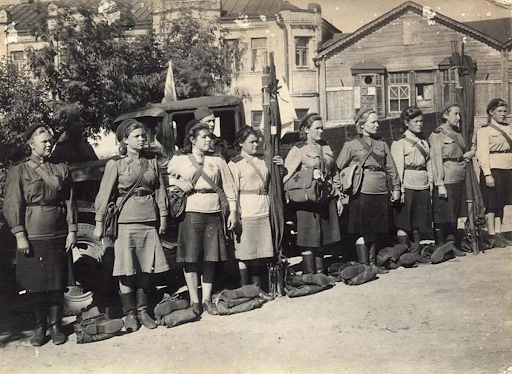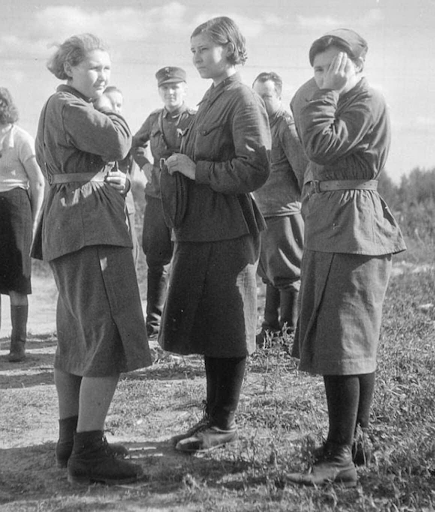Women's Impression
By Ethan Toye
Uniforms of the Women of the Red Army
Women were an invaluable part of the war effort during the course of the Great Patriotic War with over 800,000 serving. With all of these new personnel being admitted into the ranks of the military they were of course going to have to be dressed. In this article we will discuss the beginnings from male uniforms being issued to the development of the first female designated garments.
The Beret
Starting from the top we will first look at the beret. On December 17, 1936, by order of NKO No. 229, People's Commissar of Defense K.V. Voroshilov approved the new "Rules for wearing clothes by the personnel of the Red Army", in which there was a separate chapter called "The uniform of military women." In this new document a new type of headdress was specified for female members of the Red Army, a beret for everyday wear. The beret was for female military personnel who held non-combatant command and commanding positions, as well as students of military academies, schools and rear services courses, as well as the enlisted ranks of the RKKA. The documents describe the cap to be made from one solid piece of dark blue felted wool and to be with the Obr. 1936 two piece cap star.
By photographic evidence we can see that the 1936 and the 1939 stars were worn with the berets and later into the war more peculiar stars such as the 1943 pogoni rank stars and no stars at all can be seen. Another common oddity was the use of civilian berets that were in the same color as the state issued ones.
Here we have an example of the Obr. 38 beret with the 1936 cap star from my personal collection.



On November 24, 1942, a new beret was approved by Major-General of the Ministry of the Interior P.I. Drachev for a half woolen knitted beret. These berets were knitted instead of felted wool like the earlier models. There isn’t much info on their berets but one thing that has been inferred is their production being at civilian factories contracted by the military.






The Uniform
Next we move onto the uniform section starting with the various models of Gymnastyorka. By order of NKO No. 005 of January 1941, women in any combat role were to wear uniforms fully corresponding to regulations of their male counterparts including tunics, pilotki side caps, and all other equipment. Before the war women wore standard male Obr.1935 tunics but this is the first mention of its use.
Another uniform was introduced in 1941, by Order of the NKO of the USSR No. 261 of August 3, 1941, a dress uniform for everyday wear and use by rear line troops, the Obr.1941 dress. These uniforms, while being introduced early on, most of their use is seen in the later stages of the war. While they were intended for rear line use and for more formal settings on rare occasions you can see their use on the front lines. While there is no official documentation on it another variation of the dress exists, in the later half of the war the same dress can be seen but featuring a standing collar similar to the new tunic design that was being introduced.




A new tunic was introduced in 1942 for female personnel, while not officially approved by the NKO , technical documents containing a description approved by Major General of the quartermaster service P.I. Drachev on October 17, 1942 states “The body of the tunic from the front and the solid back is smooth, straight, with a slight flare at the bottom. In front of the chest darts, with a slit closed in the middle with a placket, fastened with three buttons on the loops of the collar. The placket opening is located from right to left.” In short these tunics were nearly identical to the already existing Obr.1935 tunics but they removed the chest pockets as well as added additional stitching or ‘darts’ to the chest to accommodate for breasts and to shape better to a woman’s figure. Very few of these tunics show up in photos and sadly even fewer survive in modern day collections.



In 1943 another uniform change came to the red army for both Men and Women, the new Obr. 1943 tunic. This new tunic featured a standing collar and an open placket face, there existed a pocketless version for enlisted personnel and pocketed version for officers. Many women wore the standard mens or universal versions of these tunics but a womens version of both did exist. Similar to the 1942 tunic, the women's version featured added chest darts and a left opening placket. Here we can see photos of the pocketless and pocketed version in use.





From the description approved by the Brigade commander V.N.Vlasov on December 26, 1938 we are given the standard issue skirt for female personnel. Both a summer and winter version existed for this garment. The garment is described to be very long, coming to the mid shin and even as low as the top of the ankle. The winter version was made from a blue felted wool with a hidden button closure, it featured two front pleats. The summer version of the skirt was made from cotton twill and features a single pleat.
In 1942 a new version of the skirt was introduced. This version came in both blue felted wool and protective color cotton, the skirt is much shorter than its predicessor , usually resting at the knees (perhaps to save material and time when manufacturing the skirt). Two other features are noted in the document the first being the addition of a hidden pocket at the front of the skirt as well as the button closure system no longer being hidden. Down below we can see a part of the original document, photos of the skirts in use, and an original example from my collection.



The Boots/Shoes
Lastly we move into the boots and shoes used by women in the red army. Standard issue boots were commonly issued and used by female personnel, whether it be tall jackboots, canvas boots, low boots with windings or even just low boots by themselves, with all of these boots there were two types that were specific to the female troops. The first one that is very commonly seen on both frontlines and the rear in both parade and daily life is the use of civilian shoes. These shoes were most often brought from home or picked up from cities the army was advancing through. The styles most commonly seen were either flats or very small wedges usually no more than an inch in height. Shown below are different examples of civilian shoes in use with army personnel.




The second type of female specific footwear is the “women’s boot”. These boots were like the standard jackboot of the Red Army but they had an added taller heel. No official documents exist about their creation but the most likely explanation for the phenomenon of these boots is that they were custom requested by the unit cobblers or the Voentorg. These boots seem to show up in the later half of the war and are typically seen on rearline troops and command staff.



Lastly, I want to give a big thank you to all the people who have helped me in the research, photos, and the many other facets of making this article. To my friends and colleagues, Lukas Maksin, Veronica Palamin, and Brittany Dorothy thank you all for the help that you have given me, I could not have done this without you all. Click the link below if you want to download a copy of this guide!

